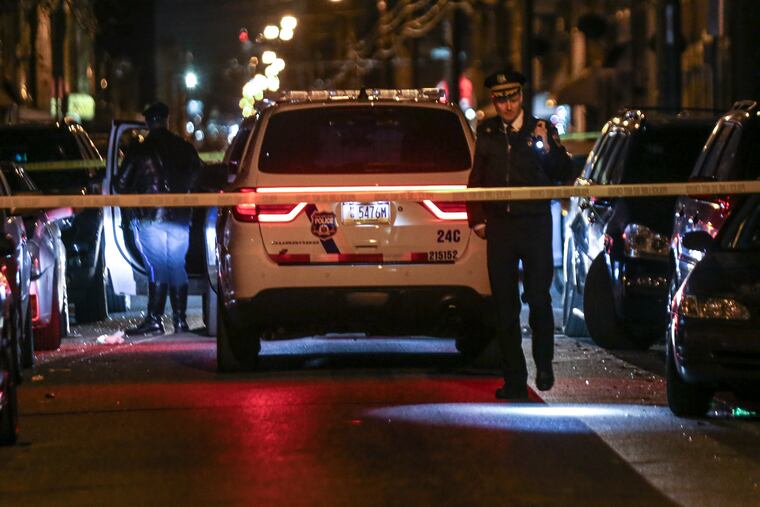Mayor Kenney should create a cabinet of experts to stem gun violence | Opinion
Solving gun violence in Philadelphia means focusing on wellbeing, including investing in neighborhoods, fixing school infrastructure, and training lifeguards.

In 2021, Philadelphia set a new record for homicides, with 551 people killed. Many of these deaths were the result of gun violence. To stop this epidemic, city leaders are supporting programs that focus interventions on those already involved in gun violence. While programs such as Cure Violence Philadelphia and the Community Crisis Intervention Program are attempting to address this issue, narrowly targeted approaches are not enough.
To permanently end the gun violence epidemic, the mayor must create a cabinet — call it an Office of Well-being and Opportunity — that has a high-level administrative member from each government department. The closest parallel, at the federal level, would be an interagency working group. This cabinet would define gun violence as a broad public health and safety issue – one that is caused in large part by poverty and intersects with everything from education to child welfare to housing.
This cabinet would be tasked with identifying and directly addressing the conditions in which gun violence thrives at a neighborhood level. In this way, it would be accountable to the well-being and safety of Philadelphia residents. Most important: Make it permanent. The cabinet has to outlast individual administrations.
Gun violence is a multidimensional problem, but leadership has been focusing too narrowly on the rate of shootings and nothing else. The city must understand how poverty and gun violence are connected at the local level. Considered as a whole, the percentage of Philadelphians living in poverty has been declining since 2011. But that number obscures a more important and nuanced picture of our city. When you look at the levels of poverty by community, individual neighborhoods like Kensington and Strawberry Mansion are getting poorer with each census count. A recent U.S. Census American Community Survey five-year estimate shows that poverty decreased in 17 neighborhoods but increased in 38 others. Often, these areas are surrounded by other high-poverty neighborhoods. These same neighborhoods have the highest levels of gun violence.
From 2019 to 2020, some neighborhoods as small as a half square mile in size witnessed over 50 shootings. In addition to human lives lost, just one shooting can produce debilitating fear and trauma, restrict daily routines, increase school dropout rates, push businesses out, weaken needed social connections and networks, and negatively impact residents’ life course trajectories.
A citywide cabinet that understands the nuances of neighborhood-level data would build more creative and useful solutions than any one government department can think up on its own. Mayor Jim Kenney should appoint a panel of residents and researchers, community advocates and investors, and city agency administrators to choose measures that link opportunity and risk to gun violence.
Considering these traumas together should create a sense of urgency. Raising a child free from experiencing violence and trauma must be a foundational value of every system. Our leadership must reflect this.
The most productive antiviolence policies will acknowledge that the problems of the last two years are only partly about the pandemic but also are linked to the structural barriers that have concentrated poverty and curtailed opportunities for Philadelphians to thrive. These barriers reside outside of the criminal and juvenile justice systems: schools devoid of nurses and counselors, crumbling and harmful infrastructure, closed parks and decaying summer swimming pools, low-quality day care, food insecurity, housing instability, overcrowded homes, limited health care, a lack of access to substance abuse and mental health treatment. These are just a few.
The cabinet will be charged with identifying what well-being means to each community, and the barriers they see as linked to the gun violence epidemic. For each neighborhood-level measure, the cabinet must work backward to identify existing funding or programs that could remove risks and promote opportunities. In addition, the data and the results must be publicly available and the cabinet must be held accountable for implementing solutions.
This does not require new funding to be identified. Dollars and programs may already exist. We just need to match the solutions to the problems.
With well-being as a foundational value for antiviolence efforts, the critical roles for the sectors outside of criminal justice will become apparent, as will the need for coordination across sectors. A simple recognition that funds spent — for instance, on capital investments for school infrastructure or training enough lifeguards to reopen pools — are also part of the groundwork for gun violence prevention. Together, the well-being measures will describe a rich picture of a poor city with great needs. The job then will be to deliver the investments to reduce the documented risks and increase the assets. The city must ensure that anti-gun violence spending aligns with the well-being metrics, where grants are carefully matched to neighborhood needs and outcomes are tracked.
In other words, how a problem is understood has a huge impact on solutions.
A city government that carefully considers the layers of obstacles facing people in high-risk places will make smart investments in solutions that match the scale of our gun violence problem. The great failure of policy and programming on this issue to date is that the solutions have not been as big as the problems they seek to solve.
Caterina G. Roman is a professor in the department of criminal justice at Temple University. John K. Roman a senior fellow in the economics, justice, and society department at NORC at the University of Chicago.
Editor’s note: A previous version of this post incorrectly stated the number of 2021 shooting victims and homicides. Last year, 551 people were killed in Philadelphia and 2,326 people were shot.